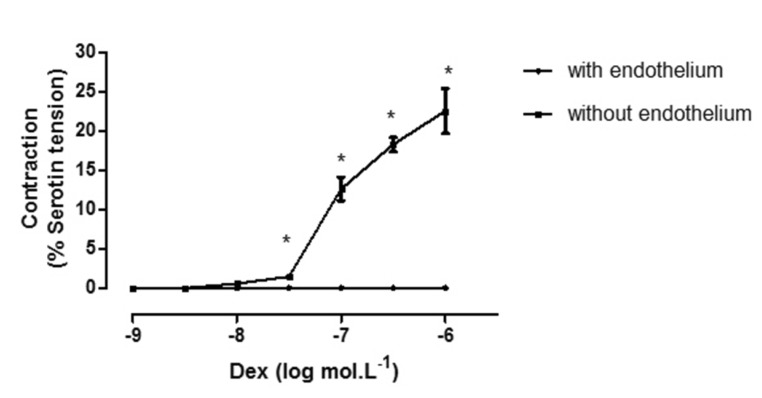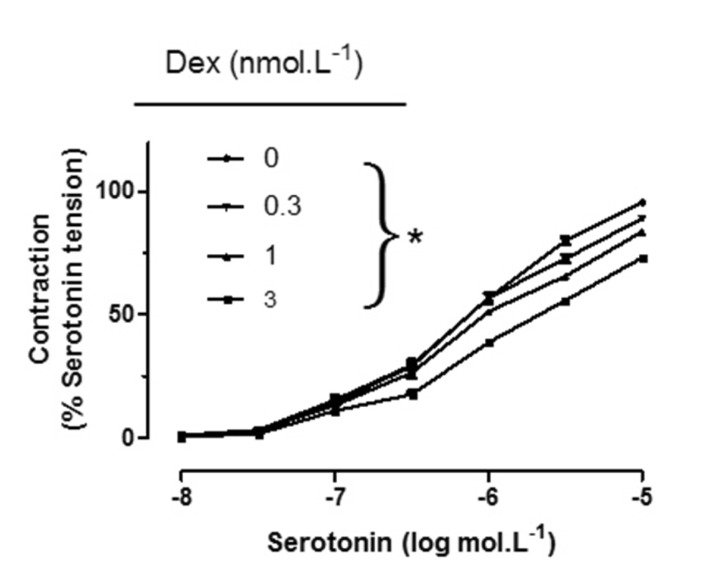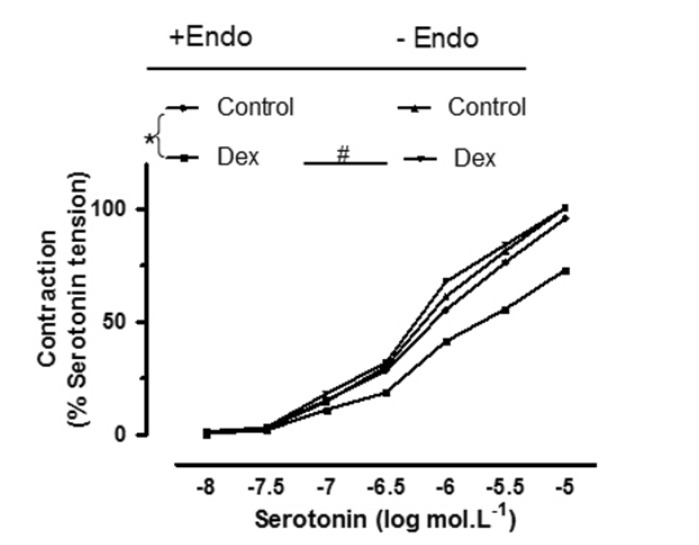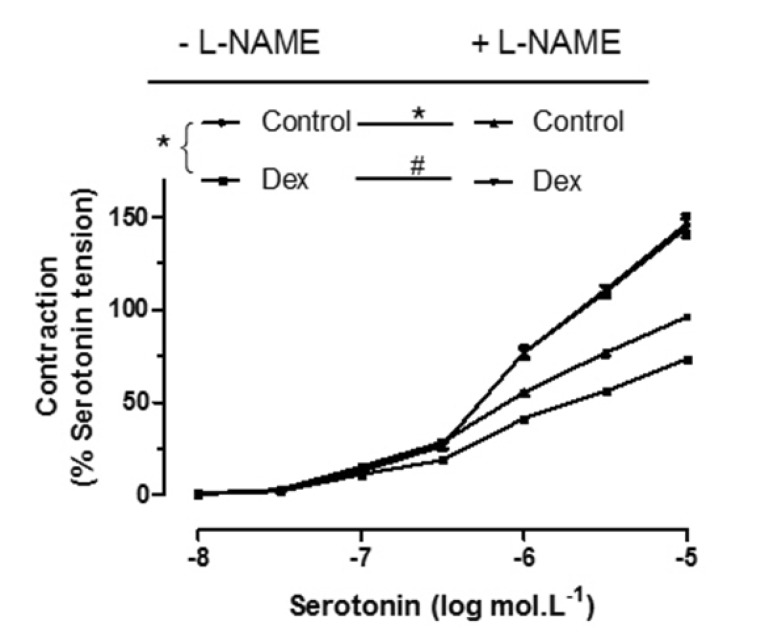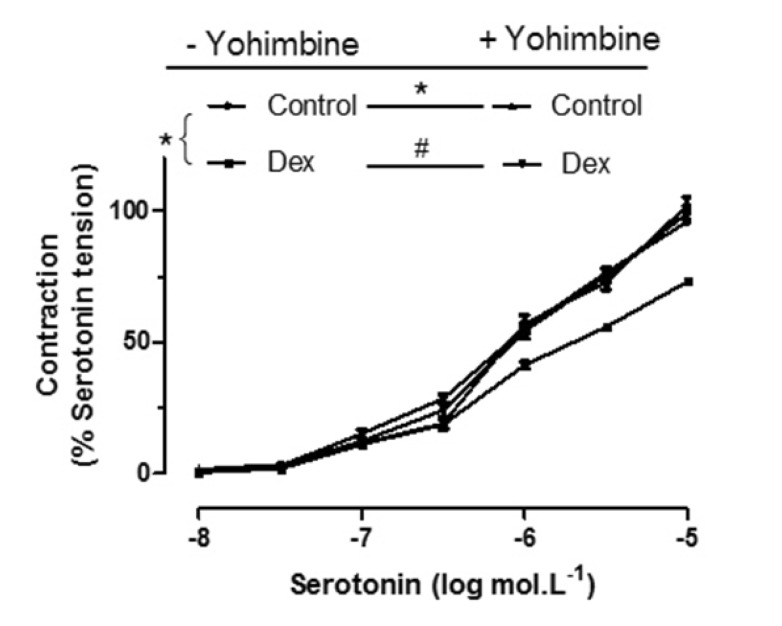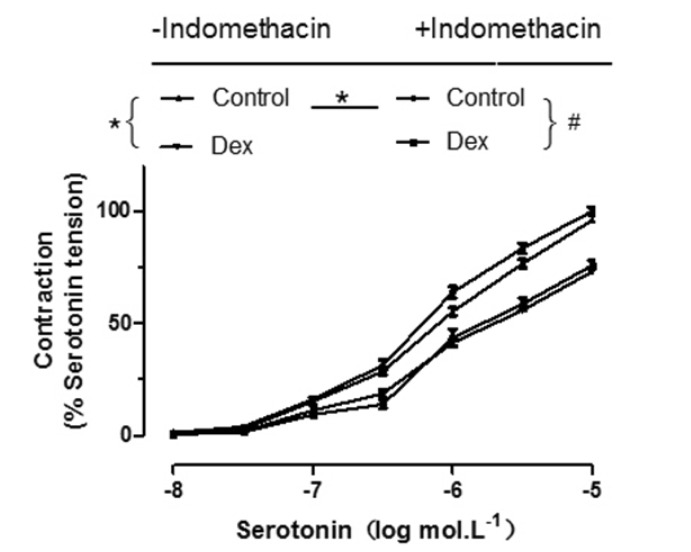Korean J Physiol Pharmacol.
2016 Sep;20(5):441-447. 10.4196/kjpp.2016.20.5.441.
Dexmedetomidine inhibits vasoconstriction via activation of endothelial nitric oxide synthase
- Affiliations
-
- 1Department of Anesthesiology, Guangdong General Hospital, Guangdong Academy of Medical Sciences, Guangzhou 510080, China. cuijianxiu@163.com
- 2Medical Research Center of Guangdong General Hospital, Guangdong Academy of Medical Sciences, Guangdong Provincial Cardiovascular Institute, Guangzhou 510080, China.
- KMID: 2350500
- DOI: http://doi.org/10.4196/kjpp.2016.20.5.441
Abstract
- Despite the complex vascular effects of dexmedetomidine (DEX), its actions on human pulmonary resistance arteries remain unknown. The present study tested the hypothesis that DEX inhibits vascular tension in human pulmonary arteries through the endothelial nitric oxide synthase (eNOS) mediated production of nitric oxide (NO). Pulmonary artery segments were obtained from 62 patients who underwent lung resection. The direct effects of DEX on human pulmonary artery tension and changes in vascular tension were determined by isometric force measurements recorded on a myograph. Arterial contractions caused by increasing concentrations of serotonin with DEX in the presence or absence of L-NAME (endothelial nitric oxide synthase inhibitor), yohimbine (α2-adrenoceptor antagonist) and indomethacin (cyclooxygenase inhibitor) as antagonists were also measured. DEX had no effect on endothelium-intact pulmonary arteries, whereas at concentrations of 10â»â¸~10â»â¶ mol/L, it elicited contractions in endothelium-denuded pulmonary arteries. DEX (0.3, 1, or 3×10â»â¹ mmol/L) inhibited serotonin-induced contraction in arteries with intact endothelium in a dose-dependent manner. L-NAME and yohimbine abolished DEX-induced inhibition, whereas indomethacin had no effect. No inhibitory effect was observed in endothelium-denuded pulmonary arteries. DEX-induced inhibition of vasoconstriction in human pulmonary arteries is mediated by NO production induced by the activation of endothelial α₂-adrenoceptor and nitric oxide synthase.
MeSH Terms
-
Arteries
Dexmedetomidine*
Endothelium
Humans
Indomethacin
Lung
NG-Nitroarginine Methyl Ester
Nitric Oxide
Nitric Oxide Synthase
Nitric Oxide Synthase Type III*
Pulmonary Artery
Serotonin
Vasoconstriction*
Yohimbine
Dexmedetomidine
Indomethacin
NG-Nitroarginine Methyl Ester
Nitric Oxide
Nitric Oxide Synthase
Nitric Oxide Synthase Type III
Serotonin
Yohimbine
Figure
Reference
-
1. Tan JA, Ho KM. Use of dexmedetomidine as a sedative and analgesic agent in critically ill adult patients: a meta-analysis. Intensive Care Med. 2010; 36:926–939. PMID: 20376429.
Article2. Gerlach AT, Murphy CV. Dexmedetomidine-associated bradycardia progressing to pulseless electrical activity: case report and review of the literature. Pharmacotherapy. 2009; 29:1492. PMID: 19947809.
Article3. MacMillan LB, Hein L, Smith MS, Piascik MT, Limbird LE. Central hypotensive effects of the alpha2a-adrenergic receptor subtype. Science. 1996; 273:801–803. PMID: 8670421.4. Talke P, Lobo E, Brown R. Systemically administered alpha2-agonistinduced peripheral vasoconstriction in humans. Anesthesiology. 2003; 99:65–70. PMID: 12826844.5. Talke P, Richardson CA, Scheinin M, Fisher DM. Postoperative pharmacokinetics and sympatholytic effects of dexmedetomidine. Anesth Analg. 1997; 85:1136–1142. PMID: 9356115.
Article6. Wong ES, Man RY, Vanhoutte PM, Ng KF. Dexmedetomidine induces both relaxations and contractions, via different {alpha}2-adrenoceptor subtypes, in the isolated mesenteric artery and aorta of the rat. J Pharmacol Exp Ther. 2010; 335:659–664. PMID: 20837990.7. Kim HJ, Sohn JT, Jeong YS, Cho MS, Kim HJ, Chang KC, Shin MK, Park CS, Chung YK. Direct effect of dexmedetomidine on rat isolated aorta involves endothelial nitric oxide synthesis and activation of the lipoxygenase pathway. Clin Exp Pharmacol Physiol. 2009; 36:406–412. PMID: 19018801.
Article8. Asano Y, Koehler RC, Kawaguchi T, McPherson RW. Pial arteriolar constriction to alpha 2-adrenergic agonist dexmedetomidine in the rat. Am J Physiol. 1997; 272:H2547–H2556. PMID: 9227530.
Article9. Seyrek M, Halici Z, Yildiz O, Ulusoy HB. Interaction between dexmedetomidine and α-adrenergic receptors: emphasis on vascular actions. J Cardiothorac Vasc Anesth. 2011; 25:856–862. PMID: 21862350.
Article10. Glusa E, Markwardt F. Characterisation of postjunctional alpha-adrenoceptors in isolated human femoral veins and arteries. Naunyn Schmiedebergs Arch Pharmacol. 1983; 323:101–105. PMID: 6136916.11. Ebert TJ, Hall JE, Barney JA, Uhrich TD, Colinco MD. The effects of increasing plasma concentrations of dexmedetomidine in humans. Anesthesiology. 2000; 93:382–394. PMID: 10910487.
Article12. Cortijo J, Martí-Cabrera M, Bernabeu E, Domènech T, Bou J, Fernández AG, Beleta J, Palacios JM, Morcillo EJ. Characterization of 5-HT receptors on human pulmonary artery and vein: functional and binding studies. Br J Pharmacol. 1997; 122:1455–1463. PMID: 9421295.
Article13. Coughlan MG, Lee JG, Bosnjak ZJ, Schmeling WT, Kampine JP, Warltier DC. Direct coronary and cerebral vascular responses to dexmedetomidine. Significance of endogenous nitric oxide synthesis. Anesthesiology. 1992; 77:998–1006. PMID: 1359812.14. Jalonen J, Halkola L, Kuttila K, Perttilä J, Rajalin A, Savunen T, Scheinin M, Valtonen M. Effects of dexmedetomidine on coronary hemodynamics and myocardial oxygen balance. J Cardiothorac Vasc Anesth. 1995; 9:519–524. PMID: 8547552.
Article15. Lawrence CJ, Prinzen FW, de Lange S. Hemodynamic and coronary vascular effects of dexmedetomidine in the anesthetized goat. Acta Anaesthesiol Scand. 1997; 41:830–836. PMID: 9265924.
Article16. Asano Y, Koehler RC, Kawaguchi T, McPherson RW. Pial arteriolar constriction to alpha 2-adrenergic agonist dexmedetomidine in the rat. Am J Physiol. 1997; 272:H2547–H2556. PMID: 9227530.
Article17. Hamasaki J, Tsuneyoshi I, Katai R, Hidaka T, Boyle WA, Kanmura Y. Dual alpha(2)-adrenergic agonist and alpha(1)-adrenergic antagonist actions of dexmedetomidine on human isolated endothelium-denuded gastroepiploic arteries. Anesth Analg. 2002; 94:1434–1440. PMID: 12032002.18. Yildiz O, Ulusoy HB, Seyrek M, Gul H, Yildirim V. Dexmedetomidine produces dual alpha2-adrenergic agonist and alpha1-adrenergic antagonist actions on human isolated internal mammary artery. J Cardiothorac Vasc Anesth. 2007; 21:696–700. PMID: 17905276.19. Masuki S, Dinenno FA, Joyner MJ, Eisenach JH. Selective alpha2-adrenergic properties of dexmedetomidine over clonidine in the human forearm. J Appl Physiol (1985). 2005; 99:587–592. PMID: 15802370.20. Snapir A, Talke P, Posti J, Huiku M, Kentala E, Scheinin M. Effects of nitric oxide synthase inhibition on dexmedetomidine-induced vasoconstriction in healthy human volunteers. Br J Anaesth. 2009; 102:38–46. PMID: 18987056.
Article21. Muszkat M, Kurnik D, Sofowora GG, Solus J, Xie HG, Harris PA, Williams SM, Wood AJ, Stein CM. Desensitization of vascular response in vivo: contribution of genetic variation in the [alpha]2B-adrenergic receptor subtype. J Hypertens. 2010; 28:278–284. PMID: 20051907.22. Kim WS, Baek SH, Lee SK, Jeon TY, Kim HY, Shin SW. Dexmedetomidine does not produce vasocontraction on human isolated gastroepiploic artery. Korean J Anesthesiol. 2011; 60:428–433. PMID: 21738846.
Article23. Sunano S, Li-Bo Z, Matsuda K, Sekiguchi F, Watanabe H, Shimamura K. Endothelium-dependent relaxation by alpha 2-adrenoceptor agonists in spontaneously hypertensive rat aorta. J Cardiovasc Pharmacol. 1996; 27:733–739. PMID: 8859945.24. Joshi MS, Ferguson TB Jr, Johnson FK, Johnson RA, Parthasarathy S, Lancaster JR Jr. Receptor-mediated activation of nitric oxide synthesis by arginine in endothelial cells. Proc Natl Acad Sci U S A. 2007; 104:9982–9987. PMID: 17535904.
Article25. Flavahan NA, Cooke JP, Shepherd JT, Vanhoutte PM. Human postjunctional alpha-1 and alpha-2 adrenoceptors: differential distribution in arteries of the limbs. J Pharmacol Exp Ther. 1987; 241:361–365. PMID: 3033211.26. Zhang G, Cui J, Chen Y, Ma J. The relaxant effect of propofol on isolated rat intrapulmonary arteries. Korean J Physiol Pharmacol. 2014; 18:377–381. PMID: 25352756.
Article27. Dempsie Y, MacLean MR. Pulmonary hypertension: therapeutic targets within the serotonin system. Br J Pharmacol. 2008; 155:455–462. PMID: 18536742.
Article28. Talke P, Lobo E, Brown R. Systemically administered alpha2-agonist-induced peripheral vasoconstriction in humans. Anesthesiology. 2003; 99:65–70. PMID: 12826844.
- Full Text Links
- Actions
-
Cited
- CITED
-
- Close
- Share
- Similar articles
-
- Immunohistochemical Expression of Placental Nitric Oxide Synthase in Preeclampsia and Normal Pregnancy
- Genetic Polymorphism of Endothelial Nitric Oxide Synthase in Korean Schizophrenic Patients
- Role of nitric oxide and distribution of nitric oxide synthase in the gustatory system
- Nitric Oxide Synthase Inhibition Alters Extracellular Glutamate Concentration after Global Cerebral Ischemia
- Distribution of Nitric Oxide Synthase Isoforms in Perioral Exocrine Glands in Rats

